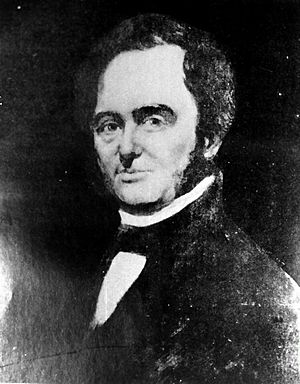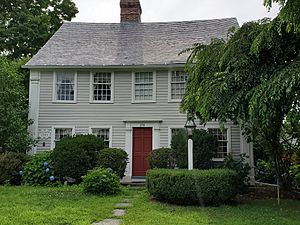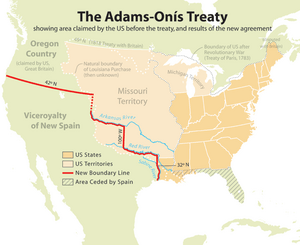Moses Austin facts for kids
Quick facts for kids
Moses Austin
|
|
|---|---|

Portrait of Moses Austin
|
|
| Born | October 4, 1761 |
| Died | June 10, 1821 (aged 59) Missouri Territory, United States
|
| Nationality | American |
| Occupation | Businessman, empresario |
| Known for | Being awarded the first land grant to settle Anglo-Americans in Spanish Texas |
| Spouse(s) | Mary Brown Austin |
| Children | Stephen F. Austin, Emily Austin Perry, James Elijah Brown Austin |
| Relatives | Nannie Webb Curtis |
Moses Austin (born October 4, 1761 – died June 10, 1821) was an American businessman and a brave pioneer. He was very important in growing the lead industry in the early United States, especially in Virginia and Missouri.
Moses Austin was the father of Stephen F. Austin. Stephen became one of the first American settlers in Texas, which was then part of Mexico. In 1820, Moses Austin received a special land grant from the Spanish government. He planned to start the first American settlement in Spanish Texas. Sadly, he passed away before he could make his dream come true. On his deathbed, he asked his son, Stephen, to finish his plan to colonize Texas. Stephen then led many settlers from Missouri to Texas in 1825. These settlers eventually asked for their own government and later won independence from Mexico, forming the Republic of Texas.
Contents
Moses Austin's Early Life and Work
Moses Austin was born on October 4, 1761, in Durham, Connecticut. His parents were Elias Austin and Eunice Phelps Austin.
In 1784, he moved to Philadelphia to work in the dry goods business with his brother, Stephen. Dry goods are things like textiles, clothing, and other items sold in a general store. Later, he moved to Richmond, Virginia, to open another dry goods store. In 1785, he married Mary Brown, who came from a wealthy family involved in iron mining. They had three children: Stephen F. Austin (born 1793), Emily Austin (born 1795), and James Elijah Brown Austin (born 1803).
Lead Mining in Virginia
Moses Austin wanted to start his own mining business. In 1789, he traveled to southwestern Virginia to look at a lead mine. He saw great potential there. By 1791, his family joined him in what is now Wythe County. Moses, his brother Stephen, and other partners worked together to industrialize the area. They built smelters (for melting metal), furnaces, stores, blacksmith shops, and mills. The small village around the mines became known as "Austinville." People started calling Moses Austin the "Lead King" because of his success.
However, the Austin brothers soon faced many debts, and their company failed. Moses left Virginia to avoid being jailed for debt, which was a common punishment at the time. He then looked toward the rich lead deposits in Missouri, which was then part of Spanish Louisiana.
Moving to Missouri and Enslaved Labor
In December 1797, Austin traveled to Missouri to explore the Spanish mines. His brother Stephen stayed in Virginia to try and save their business, which caused problems between them. The state of Virginia took much of Moses's property.
In 1798, the Spanish government gave Moses Austin a large piece of land (about 4,428 acres) for lead mining. In return, he promised to be loyal to the Spanish Crown and settle some families in Missouri. In Missouri, Austin worked with Francois Valle to learn about lead mining. Valle and other French settlers had long used enslaved African Americans and enslaved Native Americans to work in the mines. Austin quickly adopted these practices. In 1798, he bought at least one enslaved man. Moses greatly increased the use of enslaved men and women in his mining operations. Enslaved African American men were forced to do the hard work of digging and processing lead ore. Enslaved boys were made to push carts carrying ore. Enslaved women and girls were forced to prepare food for the enslaved men working in the mines.
In 1803, Missouri became part of the United States through the Louisiana Purchase. Austin became a founder and main owner of the Bank of St. Louis. But the bank failed during the Panic of 1819, a big economic crisis. This caused him to lose all his money.
Plans for Texas Settlement
Moses Austin again sought help from Spain. In 1820, he traveled to Presidio San Antonio de Béxar in Spanish Texas. He presented a plan to Governor Antonio María Martínez to bring Anglo-Americans to settle Texas. In 1821, the governor's friend, Erasmo Seguín, told Austin that he had been given a land grant. This grant allowed him to settle three hundred families in Texas. On his way back to Missouri, Austin became very ill. He died in June 1821, shortly after arriving home. His son, Stephen F. Austin, carried out his father's plan a few years later. Stephen led the three hundred families to what became the first Anglo-American settlement in Texas.
In 1885, the U.S. Supreme Court finally settled the legal claims to Austin's Spanish property in a case called Bryan v. Kennett.
Family Connections to Texas
Moses Austin had many relatives who helped settle Texas. These included his son Stephen F. Austin and his daughter Emily Austin Perry. His grandson, Moses Austin Bryan, also played a role. Moses Austin should not be confused with his grandson who had the same name. James Bryan was his first son-in-law, and James F. Perry was his second son-in-law. Moses Austin lived in a large house in Missouri called Durham Hall, named after his birthplace in Durham, Connecticut.
Why Moses Austin Wanted to Settle Texas
Moses Austin tried many business ideas before his Texas plans came true. He failed to keep the St. Louis Bank running, and bad shipping deals hurt his finances. His money problems became very serious in 1820. A sheriff in Missouri even threatened to break into his home to collect old debts. His son, Stephen F. Austin, also looked for work in Mississippi and Arkansas to help their family's poor financial situation.
In November 1820, Austin learned that the United States had signed the Adams–Onís Treaty with Spain. This treaty made present-day Texas part of New Spain's territory. Moses Austin hoped the Spanish government would allow free trade with the United States. So, he left for Texas to try and start a new business venture. His wife, Mary Brown Austin, wrote to her cousin, explaining that Moses planned to colonize Texas to provide for their family.
Negotiating with Spain
Austin's main goal was to create a trading business on the Texas coast. This would allow the United States to trade with New Spain. On December 23, 1820, Austin arrived in San Antonio to start talks with the Spanish government. He wanted to set up a trading post. After some difficulty on his own, Austin teamed up with a Spanish interpreter, Felipe Enrique Neri, Baron de Bastrop. Baron de Bastrop agreed to help Austin plan a settlement called "Austina" somewhere on the Texas coast.
On December 26, 1820, Austin and Baron de Bastrop formally asked Governor Antonio María Martínez for permission. They wanted to bring three hundred families to a port in Texas. Austin stressed that these settlers were loyal to Spain and would defend the land. Austin convinced Spain to bring back the empresario system in Texas. This old system gave land to immigrants who promised loyalty to the Spanish crown. So, Austin's settlement depended on its loyalty to the Spanish government.
Austin's Plan for the Settlement
After his successful talks in San Antonio, Austin returned to Missouri to find settlers for his new community. In April, he created a "Form of Contract for Emigration to Texas." This document explained what each person joining the settlement had to do. Austin required settlers to help build community buildings. He also told them to own a "Spanish carbine," which is a type of gun, to protect the settlement.
Austin's relationship with the settlers was more like an employer and employee. He hired them to work from their departure in May until the following January. In return, Austin promised to provide transportation, tools, and supplies to start the settlement. Although Moses Austin died before his planned trip, his son, Stephen F. Austin, continued his efforts. Austin's push led to so many Americans moving into Texas that the land became filled with them. This movement helped lead to the Texas Revolution in 1836, which later resulted in Texas joining the United States in 1845.
Moses Austin's Death
Moses Austin died from pneumonia. His tomb is located in Potosi, Missouri.
Gallery
See also
 In Spanish: Moses Austin para niños
In Spanish: Moses Austin para niños






